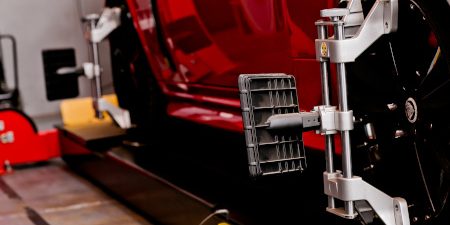When it comes to safe driving, the alignment of your wheels can play a large part. Unaligned wheels can cause poor road performance, leading you to carry out actions such as steering out of your lane unintentionally. These risk harm to yourself, other road users, and pedestrians. This month, we run through the purpose of wheel alignment and the signs that will signal that it could be time for you to have your wheels checked by a professional.
What is wheel alignment?
The process of a wheel alignment adjusts not only the wheel and tyre, but steering and suspension too. The angles are tweaked to amend how controlled the position of the vehicle is, and the tyres are adjusted to amend how they make contact with the road. The optimal alignment recommended for every vehicle is dependent on the make, model, and manufacturer of the car.
What causes wheels to lose their alignment?
As with many things, time and age can play a part in how the alignment of your vehicle changes. There are, however, aspects which can speed up the deterioration, including:
- Potholes
- Accidents
- Driving into a kerb
- Driving too fast on an uneven surface
- Natural wear and tear to the suspension of the car
How do you know your wheels need aligning?
Is your vehicle pulling to one side or the other?
Having your vehicle pull to the left or the right whether you be driving straight, or trying to steer in the opposite direction, is a tell-tale sign that your wheels are no longer correctly aligned. The danger behind this fault occurs during wetter weather, where faulty steering could lead to hydroplaning.
Is your steering wheel off-centre whilst driving?
When driving down a straight road, check the positioning of the badge in the centre of your steering wheel. If this is wonky, this could be down to the misalignment of your wheels. An off-centre steering wheel could also begin to vibrate or feel loose when navigating your way around the road.
Are your tyres squeaking?
Squealing tyres could signal uneven wear on your tyres, which release high pitched tones when driving around a bend. However, there are a range of other vehicle faults which could lead to this symptom, so its best to get checked as soon as possible to find the root of the problem and resolve it before it becomes dangerous.
Are your tyres wearing un-evenly?
By taking a look at each tyre on your vehicle, you will be able to notice any uneven wearing. Wheels that are aligned correctly will wear evenly, meaning that those which appear uneven could be a sign that your wheels are misaligned. Failing to resolve this issue could result in ineffective braking, as well as the costly action of having to replace your tyres frequently.
How often do wheels need aligning?
The required frequency of a wheel alignment can vary depending on your typical road conditions, the way in which you drive, or the age of your vehicle. As a general rule, we would recommend having your vehicle assessed every 6,000 miles or at the first sign of misalignment.
At RKH Service and Repair, our experts can provide your vehicle with expert tyre maintenance. Get in touch with our team by calling 01233 877797 or emailing admin@rkhserviceandrepair.co.uk.




